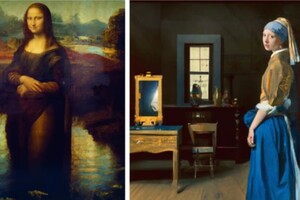Artificial intelligence has been taught to create more advanced versions of classic paintings, conditionally speaking, to see what is left behind. Da Vinci's Mona Lisa was knee-deep in the waters of the Dark River, Jan Vermeer's The Girl with the Pearl Earring is in front of a mirror, Christ Pantocrator is surrounded by trees in the fog, and over the skulls of Vereshchagin's Apotheosis of War in blue. yellow tones, an ominous cloud hung.

Художники created a variety of surreal compositions, using the artificial intelligence tool OpenAI DALL-E, which creates images from a few words of descriptive text. But some AI enthusiasts have used it for a slightly different purpose: to “expand” classical works of art with a machine learning model. First of all, to show art connoisseurs what a painting would look like if the artist undertook to expand the mise-en-scene around. The new invention is reported by Vice.
The experiment began as an attempt to recreate the unfinished business with George Washington on a dollar bill. The initiator of the development and director of AI neural.love Denis Shiryaev with the help of an extension in Telegram, which gives access to the closed test collection DALL-E, began to create models of “masks” derived from famous works of art, which indicate the algorithm updated.
Read also: Portrait of Titian: A previously stolen Renaissance painting found in Italy
The results mimic a camera that zooms in on an object, filling in parts of the background that the artist has never visualized. Now you can see the result of “looking beyond the frame” of several classic paintings, such as “Mona Lisa” by da Vinci, the medieval “Christ Pantocrator” from the Sinai Monastery? “The Girl with the Pearl Earring” by Jan Vermeer, “The Apotheosis of War” by Vasily Vereshchagin.
Experiments with Rembrandt's “Night Watch” and Klimt's triptych
This is not the first experiment with the use of machine intelligence to play with cultural heritage, including famous works of art. Last year, the Rijksmuseum in Amsterdam used AI to digitally restore Rembrandt's 1642 Night Watch, which was cut in 1715 to fit in a doorway. Other researchers have found three paintings by Gustav Klimt that were considered lost in World War II during the Nazi looting. DALL-E was also used to completely rethink classical paintings, when the program reproduced them in different styles.
Read also: The Art Club of the Council of Europe opened an exhibition of Ukrainian artists
< "From the point of view of art, I believe that these results do not give us much," said Shiryaev. "But for me personally it was a pleasant trip to feel the same, familiar art, but from unexpected sides." Museum.


